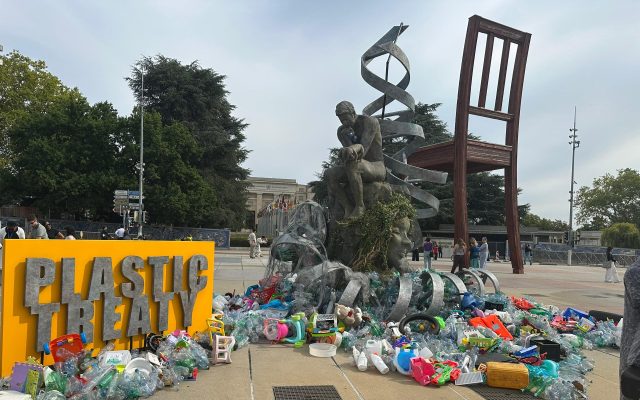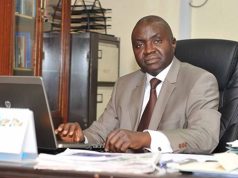As over 3,000 delegates and participants from 184 countries gathered in Switzerland’s capital city, Geneva, for the second part of the fifth session of the United Nations Environmental Programme Plastic Treaty negotiations (INC-5.2), a six-meter-high sculpture, strategically placed in an open field opposite the renowned Place des Nations, the venue of the meeting, sends an important message to the negotiators.

This sculpture was unveiled on 4 August, and christened “The Thinker’s Burden.” It has been described as a provocative installation by Canadian artist Benjamin Wong, who explained the significance of the work to delegates in Geneva. The sculpture captures the severity of the plastic crisis.
“Plastic pollution is not just an environmental issue — it’s a public health emergency,’’ UNEP says of the sculpture, which has now become a mini tourist site. It’s placed before the symbolic Alley of Flags outside the United Nations Office—confronting each delegation with a silent but striking message: “an ambitious treaty is not optional — it is essential.”
During a visit to the spot where the sculpture is placed in Geneva, PREMIUM TIMES observed that the art work is a reflection of a pensive female figure cradling a child atop a representation of the earth ( some delegates call it mother earth).
It was all entwined by a strand of materials moulded to form an image of DNA, with pieces of empty plastic bottles used to design the surrounding floor.
“This is not just art — it’s a call to conscience,” Sarah Dunlop, a professor and head of Plastics and Human Health at the Minderoo Foundation, which co-sponsored the piece, said about the artwork.
She said “The Thinker’s Burden” represents the moral, environmental, and health weight negotiators carry here in Geneva. “This treaty is a once-in-a-generation chance to protect people everywhere from toxic plastics — and to make polluters pay.”
Plastic Treaty INC-5.2
On Tuesday, negotiators from over 175 countries reconvened in Geneva for what could be the final round of talks to forge a legally binding global agreement on plastic pollution. But deep divisions persist.
This is against the backdrop of concerns emerging from a coalition of “High Ambition Countries”, including several African and Pacific Island nations advocating for strong upstream measures such as caps on plastic production and a phase-out of toxic additives.
Also, these nations want a situation where the final text that would be adopted includes robust financial mechanisms for poorer countries, enforceable provisions, and clear national action plans.
Meanwhile, a bloc of Low Ambition Countries, presumed to be backed by some of the world’s largest petrochemical interests, are said to be pushing for softer, downstream solutions focused on recycling and waste management.
The sculpture, now a centre of attraction for many delegates currently attending the meeting, was said to have been crafted from sustainable materials, including wood, steel, papier mâché, and living vines.
It was constructed with the help of Swiss fabricators SLS Illusions and over two dozen community partners. Organisers said that more than 20 cubic metres of plastic waste were sourced from local contributors to form the base and surrounding elements of the piece.
“Micropoastics in our bodies”
Mr Wong, who put the work together with his team and has exhibited at global summits including the UN and World Economic Forum, said the work is deeply personal.
“Microplastics and toxic chemicals are already in our bodies — in the air we breathe, the water we drink, and the food we eat,” he said.
The artist said “The Thinker’s Burden” is meant to remind everyone that the true cost of plastic pollution is measured in human health, even before birth.
“It’s no longer a distant problem. It is already inside us,” he added.
In his remarks, INC Chair Luis Valdivieso said the artwork reminds them of reasons why their work matters, and that it highlights both the responsibility they carry and the urgency to act.
Meanwhile, environmental experts and scientists have warned that the outcome of the ongoing negotiations could determine whether the treaty truly addresses the root causes of the crisis — or merely manages its fallout.
“Art is a powerful medium to convey scientific facts to a wide audience and the Thinker’s Burden delivers a compelling and graphic message,” said Bethanie Almroth, a professor of Ecotoxicology at the University of Gothenburg, Sweden.
She said the sculpture captures the knowledge and understanding of the broad impact of plastics and chemicals on human health and the environment.









